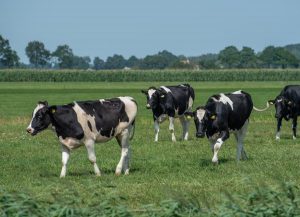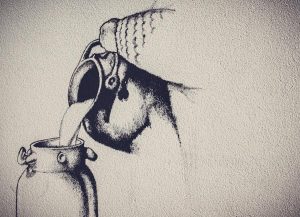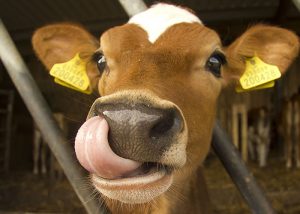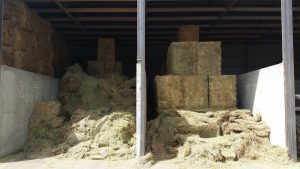Alvaro Garcia
Diarrhea and respiratory disease are the two leading death losses in un-weaned heifer calves. Respiratory problems have increased in the last 20 years, causing more than 20% percent of all dairy calf losses. Heifers that survive continue to perform poorly as adult cows.
Calf deaths within the first 48 hours of life are significant and greatly influenced by nutrition, environment, and management. One of the most prevalent reason for these death losses is the inadequate passive transfer of immunity through colostrum received from the dam. Current guidelines suggest calves should receive 3–4 quarts of high-quality colostrum within 1 hour of birth and 3 additional quarts within the next 12 hours.
If colostrum ingestion is inadequate, esophageal feeders can be used making sure that 3–4 quarts are administered within 1 hour of birth. Pooling colostrum is also becoming popular with large farms because it increases the immune competence of the calves (or their ability to respond to a more diverse pool of pathogens).
Have you fed your calf enough colostrum?
One way to find out if colostrum has supplied adequate amounts of immunoglobulins (IgG) is to measure either IgG directly or serum total protein in blood serum. Serum total protein measured with a refractometer is highly correlated with serum IgG levels. Measuring serum total protein in a group of calves is more meaningful than individual readings; at least 80% of a group of calves should have serum protein levels of 5.5 g/dL or higher.
Even with adequate colostrum feeding, the functionality of the young calf immune system is also influenced by the availability of some key essential trace minerals. Insufficient concentration of zinc, copper and selenium have been associated with increased ratio of morbidity in young calves.
Research has reported that the postnatal injection of zinc, manganese, copper, and selenium before 30 days old, reduced the incidence of calf diarrhea and pneumonia. It has been proposed that these effects are mediated by improvement in the calf’s immunity particularly increased neutrophil function and antibody production.
Injections of zinc, copper, selenium and manganese have increased the humoral and cellular immune response to attenuated live bacterins and modified-live viral vaccines. Most of these studies, however, have been conducted in two-month or older calves, and almost none within the first month of life.
This early injection of trace minerals will still be within the period where maternal immunity would interact with the response to vaccines and at a time when the immune response of the calf is still developing.
A recent New Zealand study on neonatal young Jersey-Friesian calves (Bates et al. 2020), evaluated the effects of an injectable trace mineral product containing zinc, manganese, copper and selenium, on the cellular and humoral immune response to an inactivated vaccine.
Effect of trace minerals on cellular and humoral immunity
Calves were born on pasture and picked-up twice a day (am and pm), brought to the rearing facility and navel-sprayed with iodine tincture (10% iodine). Calves picked-up in the morning received 4 liters of pooled colostrum from cows that had calved overnight. Calves picked-up in the afternoon received 3 liters of pooled colostrum from cows that calved that day. As a result, all calves received colostrum from the first milking of cows calving within 7–15 hours.
Blood was sampled from 30 calves right away and were then assigned to treatment and control groups based on age, breed, and the concentration of serum total protein, copper, selenium, zinc, and manganese. Another five calves were randomly selected to be a sentinel group for exposure to Salmonella and received no injections at all.
Treatment and control calves were injected with a killed Salmonella antigens vaccine at 2 and 6 weeks of age. The treatment group received also an injection of 1 mL/50 kg of a trace mineral supplement containing zinc (40 mg), manganese (10 mg), selenium (5 mg), copper (15 mg) per mL. Blood samples were obtained from 2 to 9 weeks for assay of immune function.
Housing was in covered, open front bay-sheds with solid walls up to 1.5 m in groups of 10–12 with 1.5 m2 space per calf. From 1 – 4 days old, calves received 2 liters of pooled colostrum every 12 hours. Thereafter, calves received pooled colostrum and saleable milk from milking cows in the herd with access to hay, water and calf starter (20% protein).
From days 14 to 21 of age calves had access to perennial ryegrass and were fed two identical meals increasing from 2 to 3 liters per feeding for the first 14–21 days and then 6–8 liters once daily until the end of the experiment.
At 3, 4, 5, 6, 7, 8 and 9 weeks of age, blood samples were collected from the 30 study calves and the 5 sentinels. Samples were tested for monocyte function, in vitro assay of antigen induced IFN-γ release by peripheral blood monocytes and antibody levels to combined strains of S. Typhimurium, S. Bovis-morbificans, S. Hindmarsh and S. Brandenburg.
Cell response occurred, but no humoral response
At three and four weeks, white blood cells from trace mineral-injected calves had an increased percentage of cells phagocytosis and increased number of bacteria ingested per cell. No differences were detected in gamma interferon response or Salmonella antibody titers.
Results of this experiment showed that the injection to neonatal calves of the trace minerals described increased the phagocytic capability of their white blood cells and the percentage of cells phagocytosis and the number of bacteria ingested per cell.
Reference
A. Bates, M. Wells, R. Laven, L. Ferriman, A. Heiser, C. Fitzpatrick. Effect of an Injectable Trace Mineral Supplement on the Immune Response of Dairy Calves. Res Vet Sci. 2020 Jun;130:1-10.
© 2020 Dairy Knowledge Center. All Rights Reserved.









